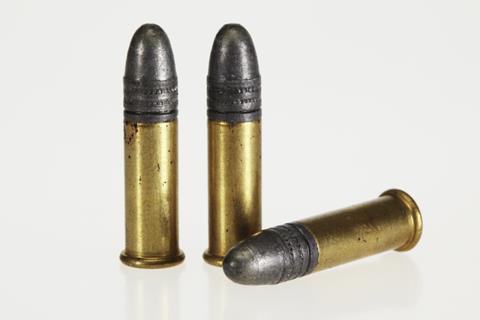Computational methods are making firearm evidence more statistically sound

It was mid-morning on 14 February 1929 when seven men gathered in a Chicago, Illinois garage. One man was a mechanic who reportedly worked on cars for a lucrative but criminal enterprise five of the remaining six men were involved in – the syndicate headed by mobster George ‘Bugs’ Moran. The final man was an optometrist who reportedly ‘found excitement in associating with gentlemen reported to be “tough”’. Bugs Moran, a rival to fellow Chicago mobster Al Capone, was supposed to attend but failed to show. Criminal enterprises like those run by Moran and Capone were trafficking in an array of illegal products and services during one of the most infamous periods of US history – Prohibition. The much debated movements to dry out America saw the prohibition of ‘the manufacture, sale, or transportation of intoxicating liquors’. The ‘noble experiment’ of Prohibition is often pointed to as having ‘produced crime, violence, and a flourishing illegal liquor trade’.
The illegal liquor trade was seemingly the real business that went on in the aforementioned garage, which was described as a Moran gang ‘whisky depot’. So perhaps it was unsurprising to neighbors when a car ‘of the type used by police squads in Chicago’ arrived on that February morning. Four or five men in uniform exited the vehicle, half of whom ‘were carrying weapons resembling riot guns’. What happened next, however, sent shockwaves across the US. The seven men in the garage were lined against an interior wall and shot in what became known as the St Valentine’s Day Massacre.
News reports of the massacre were rife with speculation that the shooters were either police on a rival gang’s payroll or rival gangsters in cop costumes. Either scenario seemed plausible at the time, given the acknowledged police corruption and the tendency for rival gangs to ‘remove competition’. Toward identifying the culprits, New York ballistics expert Calvin Goddard was brought in to aid investigators, and concluded that two different Thompson (‘Tommy’) machine guns had been used. He excluded Thompson guns ‘in the hands of’ Chicago area police. Later, Goddard would identify two Thompson guns seized roughly 100 miles from Chicago during a separate criminal investigation as the weapons used. The suspect in that case turned out to be one of the suspects in the massacre.
Goddard’s firearm identification relied significantly on using a comparison microscope to compare tool marks on reference bullets and cartridges to evidence exhibits to ascertain if they were fired from the same firearm. Forensic ballistics examiners work in a similar fashion to this day. But starting in the 2000s, concerns as to the underlying theoretical and statistical foundation of the discipline became widely known.3 Asserting that characteristics on fired bullets and cartridges are sufficiently unique to go beyond elucidating class (for example, type of weapon or ammunition) to the identification of a particular firearm owned by a particular person (this Ruger 9mm owned by J Doe) requires extensive study and standardisation.4–6 Now, computation is supporting cutting-edge research to continuously meet these requirements.7
Even confidently identifying whether material is gunshot residue can be an analytical challenge
Toward boosting firearm identifications, over the last 10 years researchers at the National Institute of Standards and Technology (NIST) have developed the Congruent Matching Cells (CMC) method, which divides topography images of cartridges into cells. Cell-by-cell, from reference to suspect item image, areas are computationally compared. Declaring a match, note the researchers, requires ‘cell pairs that meet all similarity and congruency requirements’.4 Cell correlation data also enabled researchers to estimate error rates and other statistical measures. NIST’s work is ongoing to further standardise, automate and commercialise the CMC process.
The chemical composition of gunshot residue (GSR) can also provide valuable insight in shooting investigations.9, 10 GSR is a mixture of organic and inorganic species expelled from a firearm in an airborne plume that can deposit on the shooter and victim, along with surrounding surfaces and persons. Given our complex chemical environment, even confidently identifying whether material is GSR can be an analytical challenge. For inorganic GSR, scanning electron microscopy – energy dispersive spectroscopy (SEM–EDS) is the go-to method, allowing analysts to probe both the morphology of GSR particles and their elemental composition.Laser-induced breakdown spectroscopy (LIBS) is also emerging as a useful tool for the analysis of both organic and inorganic GSR.8,10 Both techniques paired with machine learning are strengthening the foundation and framework of GSR comparison work.
Recent work led by researchers at West Virginia University, US, featured a large population study of shooters, non-shooters, and background profiles. Samples were analysed using multiple techniques, including LIBS, with cross-validation by SEM–EDS.8 Diverse training sets and machine learning techniques – including a neural network classifier method – enabled researchers to confidently classify a sample as GSR or not with an accuracy of greater than 93%. While this study included realistic samples analysts would encounter in their case work, it did not involve actual casework samples.
Casework was the dataset for researchers at the Netherlands Forensic Institute, with nearly 2000 samples from 210 criminal cases analysed using a standard SEM-EDS method.7 Machine learning models trained on casework aimed to differentiate GSR particles originating from the same shot from those particles originating from different shots, and were validated with casework and independent cartridge data. The researchers’ score-based system shows promise in assisting analysts in judging the likelihood of a same-shot or different shot scenario. Cutting-edge computational work is allowing researchers to deconvolute complicated scenes and matrices with more statistical confidence than ever before.
References
1 C Goddard, J. Crim. Law Criminol., 1930, 1, 60 (DOI: 10.2307/1147257)
2 H Wolffram, Acad. Forensic Pathol., 2021, 11, 52 (DOI: 10.1177/1925362121100251)
3 J Song et al, Forensic Sci. Int., 2020, 317, 110502 (DOI: 10.1016/j.forsciint.2020.110502)
4 J Song et al, Forensic Sci. Int., 2018, 284, 15 (DOI: 10.1016/j.forsciint.2017.12.013)
5 N F Zhang, Forensic Sci. Int., 2021, 326, 110912 (DOI: 10.1016/j.forsciint.2021.110912)
6 H Song and J Song, J. Forensic Sci., 2022, 67, 1417 (DOI: 10.1111/1556-4029.15026)
7 T Matzen, Forensic Sci. Int., 2022, 335, 111293 (DOI: 10.1016/j.forsciint.2022.111293)
8 K Menking-Hoggatt et al, Forensic Chemistry, 2022, 29, 100429 (DOI: 10.1016/j.forc.2022.100429)
9 A J Schwoeble and D L Exline, Explanation of Gunshot Residue. In Current Methods in Forensic Gunshot Residue Analysis, Taylor & Francis, 2000
10 T Trejos et al, Forensic Chemistry, 2018, 8, 146 (DOI: 10.1016/j.forc.2018.02.006)












1 Reader's comment